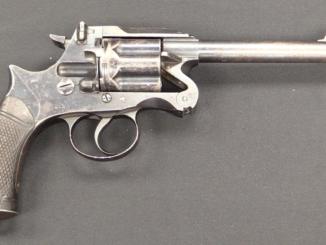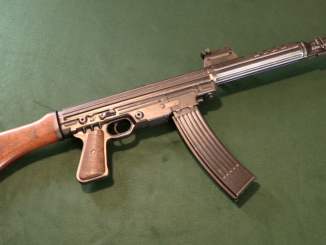The Model 1871 Mauser was adopted as the newly united Germany’s first standard rifle, and it was a good design. However, it was a single shot rifle and soon it became apparent that the additional firepower of a magazine rifle was necessary to maintain military parity. A number of different conversion methods were tested by the German military , and ultimately a tube magazine under the barrel was adopted as the Gewehr 71/84.
One of the other competing designs was this external wraparound magazine. It held cartridges outside the rifle, with a mechanism to kick a cartridge into the action’s feedway when an empty case was ejected. While mechanically clever and probably reasonably reliable in sterile conditions, it has clear and serious disadvantages compared to a fully integral magazine like the type ultimately adopted.
The rifle was pulled from the auction after I finished my video, so it is not actually for sale. Doesn’t make it any less interesting to look at, though!




“Welcome to the ‘we lose again’ party, Herr General.” Whoever designed this magazine clearly didn’t understand field conditions and the high probability that the rifle would get bashed a lot in battle…
With modern materials (polymers, better steels) this design could work. You will still have a single shot. Stick magazines can fail all the time when dented.
That’s why I’d rather design sporting rifles than military rifles. I don’t know how many Mausers made it into civvie hands at that early date, but I can imagine a brisk trade in these for sport shooters, gamekeepers, nobility blasting at driven game, and others who could afford both the kit and the required gunsmithing.
Considering how long commercial loads for the 11mm, or 11x60R, or 11.15x60R, or .43 Mauser were available, I’m sure there were plenty of folks shooting these guns at game out in the field. If you keep your eyes open at gun shops and shows, you’ll occasionally see these rifles as cut down sporters, although there’s no way to tell when the sporterizing was done. It’s still possible to reload: http://youtu.be/vz6xSjB1_qQ and shoot this cartridge: http://youtu.be/QjZiJ65rzgU so there’s got to have been continuity in civilian use from when they were new till now. A good question might be, back in the black powder era, would a hunter have chosen this rifle over the other available options? My guess would be that these guns were probably very expensive when new, more expensive than a high quality single-shot, dropping-block sporting rifle, and they were more complex and have a much worse trigger. So, if I’m getting kitted out for a hunt where I needed this kind of power, (about .45-70 level of performance), I’d probably have gone with an established, reliable, and simple dropping-block single-shot with a good double-set trigger rather than a bolt action service rifle. Now, once these rifles and ammunition hit the surplus market that all changes. Then you could get these rifles and their cartridges for a small fraction of the cost of any new product, so they become very attractive for the budget-conscious hunter.
Well said, Brian. The “horseshoe” magazine makes sense as a modification kit for military surplus, but why bother with such a modification if it requires the hunter to change his charging stroke? If he’s trying to maintain stealth while working the bolt, the cases will jam or fly everywhere.
I could be wrong, though.
Ian, thank you for showcasing this. As european military rifles of this era are my main interest, I found this to be quite educational. Do you recall what the estimate was, before it was pulled?
Also in an amusing turn of fate, I am taking a coworker shooting tomorrow, and one of the offerings on the menu, so to speak, is my Spandau 71/84. While that is a handier package for sure, this one is not as kludgy as it could be. (There is a pic floating around of a similar mod to a French Gras, and it looks like a mailbox stuck to the receiver… THAT I’d like a closer look at).
Double shotgun, cartridge holder, mounted on the barrels. Break, eject, new cartridges appear in your hand.